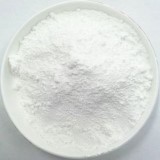 |
Calcium Phosphate Tribasic or Tricalcium Phosphate USP FCC Food Grade Supplier Exporter Manufacturers' Representative |
Email: info@ammol.org |
Call Toll Free +1-855-552-6665 |
Calcium Phosphate Tribasic or Tricalcium Phosphate
CAS Number: 12167-74-7, 7758-87-4, 62974-97-4, 7758-23-8
Molecular Formula: Ca3(PO4)2 Formula weight 310.18,
Ca5OH(PO4)3 Formula weight 502.31,
Ca10(OH)2(PO4)6 Formula weight 1004.61,
INS: 341(iii) CAS 7758-87-4,
CAS 1306-06-5,
CAS 62974-97-4

Calcium Phosphate Tribasic or Tricalcium Phosphate Suppliers
Tribasic Calcium Phosphate USP Grade Specifications
Tribasic Calcium Phosphate
Ca5(OH)(PO4)3 502.31
Calcium hydroxide phosphate (Ca5(OH)(PO4)3).
Calcium hydroxide phosphate (Ca5(OH)(PO4)3) CAS 12167-74-7
Tribasic Calcium Phosphate consists of a variable mixture of calcium phosphates having the approximate composition 10CaO·3P2O5·H2O. It contains not less than 34.0 percent and not more than 40.0 percent of calcium (Ca).
Identification:
A: To a warm solution in a slight excess of nitric acid add ammonium molybdate TS: a yellow precipitate is formed.
B: It responds to the flame test for Calcium.
Loss on ignition: Ignite it at 800 for 30 minutes: it loses not more than 8.0% of its weight.
Water-soluble substances: Digest 2 g with 100 mL of water on a steam bath for 30 minutes, cool, add sufficient water to restore the original volume, stir well, and filter. Evaporate 50 mL of the filtrate in a tarred porcelain dish on a steam bath to dryness, and dry the residue at 120 to constant weight: the weight of the residue does not exceed 5 mg (0.5%).
Acid-insoluble substances: If an insoluble residue remains in the test for Carbonate, boil the solution, filter, wash the residue well with hot water until the last washing is free from chloride, and ignite the residue to constant weight: the weight of the residue does not exceed 4 mg (0.2%).
Carbonate: Mix 2 g with 20 mL of water, and add 3 N hydrochloric acid, drop wise, to effect solution: no effervescence is produced.
Chloride: Dissolve 500 mg in 25 mL of 2 N nitric acid, and add 1 mL of silver nitrate TS: the turbidity does not exceed that produced by 1.0 mL of 0.020 N hydrochloric acid (0.14%).
Sulfate: Dissolve 500 mg in the smallest possible amount of 3 N hydrochloric acid, dilute with water to 100 mL, filter, if necessary, and to 25 mL of the filtrate add 1 mL of barium chloride TS: the turbidity does not exceed that produced by 1.0 mL of 0.020 N sulfuric acid (0.8%).
Arsenic: The limit is 3 ppm.
Barium: Mix 500 mg with 10 mL of water, heat, add hydrochloric acid drop-wise until solution is effected, and then add 2 drops of the acid in excess. Filter, and add to the filtrate 1 mL of potassium sulfate TS: no turbidity appears within 15 minutes.
Dibasic salt and calcium oxide: Weigh accurately about 1.5 g, and dissolve by warming with 25.0 mL of 1 N hydrochloric acid VS. Cool, and slowly titrate the excess of 1 N hydrochloric acid, while agitating constantly, with 0.1 N sodium hydroxide VS to a pH of 4.0, determined potentiometrically. Not less than 13.0 mL and not more than 14.3 mL of 1 N hydrochloric acid is consumed for each g of salt, calculated on the ignited basis.
Limit of fluoride: [NOTE—Prepare and store all solutions in plastic containers.]: The limit is 0.0075%.
Limit of nitrate: Mix 200 mg with 5 mL of water, and add just sufficient hydrochloric acid to effect solution. Dilute with water to 10 mL, add 0.20 mL of indigo carmine TS, then add, with stirring, 10 mL of sulfuric acid: the blue color persists for not less than 5 minutes.
Calcium Phosphate, Tribasic FCC Food Grade Specifications
Tricalcium Phosphate; Precipitated Calcium Phosphate
Calcium Hydroxyapatite
Ca3(PO4)2 Formula weight 310.18
Ca5OH(PO4)3 Formula weight 502.31
Ca10(OH)2(PO4)6 Formula weight 1004.61
INS: 341(iii) CAS 7758-87-4
CAS: 1306-06-5
CAS: 62974-97-4
DESCRIPTION
Calcium Phosphate, Tribasic, occurs as a white powder that is stable in air. It consists of a variable mixture of calcium phosphates. It is insoluble in alcohol and almost insoluble in water, but it dissolves readily in dilute hydrochloric and nitric acids.
Function: Ant caking agent; buffer; nutrient; clouding agent.
REQUIREMENTS
Identification
A. Add ammonium molybdate TS to a warm solution of sample in a slight excess of nitric acid. A yellow precipitate forms.
B. Dissolve about 100 mg of sample by warming it with 5 mL of 2.7 N hydrochloric acid and 5 mL of water; while shaking, add 1 mL of 6 N ammonium hydroxide, drop-wise and then add 5 mL of ammonium oxalate TS. A white precipitate forms.
Assay: Not less than 34.0% and not more than 40.0% of calcium (Ca).
Arsenic: Not more than 3 mg/kg.
Fluoride: Not more than 0.0075%.
Lead: Not more than 2 mg/kg.
Loss on Ignition: Not more than 10.0%.
We also supply Calcium Phosphate Tribasic or Tricalcium Phosphate BP Ph Eur Grade.
Please visit SDS Safety Data Sheet of Calcium Phosphate Tribasic or Tricalcium Phosphate Suppliers.
American Molecules, also known as ammol.org is a distributor, supplier and manufacturers' representative of all types of Pharmaceuticals, Functional Ingredients, Excipients and Specialty Chemicals in Texas USA. Our principals manufacture supply and export USP NF BP, Ph Eur, etc grades of chemicals pure and reagent grade, mineral fortifiers, FCC food grade. Tailor made particle size and customized specifications are offered. The principal's facility is having one or more of the certifications like FDA approval and GLP, cGMP, ISO9001, ISO14001, ISO/IEC 17025, ISO22000, FSSC 22000, ISO45001, FSSAI, Kosher, HALAL, COPP, WHO-GMP certified and Written Confirmation (WC) for export to Europe is available. The manufacturers suppliers and exporters observe WHO Good Manufacturing Practices and Good Laboratory Practices.





Suppliers and Manufacturers' Representative:

9910 Bent Oak Dr
Houston, TX 77040, USA
Call Toll Free: 1-855-55-AMMOL 1-855-552-6665
Email: info@ammol.org